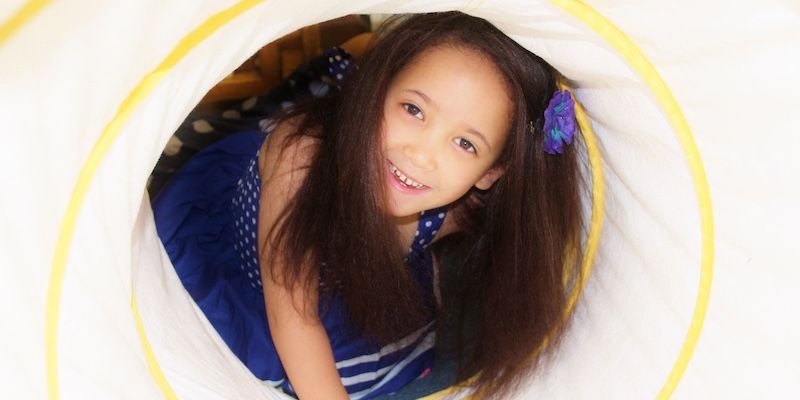CBT for Children: A Guide for Helping Kids in Therapy
 Helping children become aware of the ways in which thoughts can influence emotions and behavior is one of the most valuable lessons we can bequeath.
Helping children become aware of the ways in which thoughts can influence emotions and behavior is one of the most valuable lessons we can bequeath.
At a time when social, cognitive and emotional development is expeditious, reframing counterproductive thinking and the beliefs that underlie that thinking is integral to navigating the emotional and personal challenges experienced during childhood.
Cognitive-behavioral therapy (CBT) can help children to reframe how they identify, interpret and evaluate their emotional and behavioral reactions to negative experiences.
Realizing that emotions and behaviors can be regulated and managed is empowering and can lead to improvements in self-control, emotion regulation, coping skills, and emotional awareness during this critical developmental stage.
The following article will explore the research and efficacy of cognitive-behavioral therapy for children, the childhood and teen issues that CBT may help to address, and the benefits of using CBT with children and adolescents.
Before you read on, we thought you might like to download our three Positive CBT Exercises for free. These science-based exercises will provide you with a detailed insight into Positive CBT and will give you the tools to apply it in your therapy or coaching.
This Article Contains:
Is CBT an Effective Form of Therapy for Children?
Behavioral and cognitive theories of human psychopathology are at the very heart of cognitive behavioral therapy. By targeting multiple areas of potential vulnerability with developmentally-guided strategies and flexible intervention pathways, CBT has been shown to be an effective treatment for a wide range of psychological problems in adults.
In recent years a growing body of evidence also supports the effectiveness of CBT with children and young people for numerous conditions including, but not limited to; depression, generalized anxiety disorder, obsessive-compulsive disorder, school phobia, eating disorders, self-harm and conduct problems (Scott, 2010).
Anxiety disorders are the most common form of psychopathology in children and adolescents (Abbo et al., 2013). In children, the symptoms of Generalized Anxiety Disorder (GAD) are often exhibited as rumination on their health and the health of loved ones, school, the opinions of others, and social issues.
Worrying about the potential negative outcomes coupled with an underdeveloped capacity to cope with them can be detrimental to young people in a number of ways.
Clinical trials have established the effectiveness of CBT for treating children with anxiety disorders. Reinecke, Dattilio, & Freeman (2003) found that 55–65% of children no longer met the criteria for an anxiety disorder following treatment.
Additionally, the results from this study indicated that CBT can potentially assist even very young children (under the age of 7) in managing moderate anxiety.
Beck, Rush, Shaw, and Emery (1979) proposed that depressed individuals have characteristic thoughts and beliefs which maintain their depressed mood and behaviors. When depressed, people tend to remember the bad things that have happened to them, often overlooking the good things.
Target (2002) stated that around 30-40% of adolescents will experience an episode of major depressive disorder at some point, with the strongest risk factors being a genetic vulnerability to depression and exposure to psychosocial stress such as parental divorce, bereavement, and abuse.
CBT aims to identify and replace negative thoughts, using positive behavioral skills to create and maintain positive moods and healthy relationships.
Garber, Clarke, and Weersing (2014) examined the effect of combining depression education and CBT in the treatment of children and adolescents. Results from this study showed that group CBT programs reduced the incidence of depression in treated adolescents after 12 months, indicating that school-based CBT prevention may be a promising approach for young people reporting high rates of depressive symptoms.
Multicomponent CBT can lead to remediation, redefinition, and reeducation in children with ADHD (Braswell & Bloomquist, 1991). Stressing the need for collaborative goal-setting and training in anger management and social skills, Braswell and Bloomquist indicated that CBT for children and adolescents with ADHD is most beneficial in group treatments involving family and teachers.
What Childhood and Teen Issues Can CBT Best Address?

These adjustments can help bring about changes in the symptoms of a number of issues associated with childhood and adolescence.
Eating disorders
Eating disorders are relatively prevalent and serious psychological disorders that commonly emerge during adolescence. Around 40-60% of girls aged 6-12 expressed concerns regarding their weight, with around 13% suffering from an eating disorder by age 20 (Smolak, 2011).
Studies of adolescent boys with eating disorders suggest that the prevalence of eating disorders is increasing, with boys most commonly being admitted to hospital for an eating disorder at age 13 (Stice, Marti, Shaw, & Jaconis, 2010).
Cognitive-behavioral therapy for eating disorders addresses distorted thoughts about weight and self-image through ongoing cognitive restructuring.
Adolescents with recurrent binge-eating demonstrated abstinence from binging following group CBT treatment. Furthermore, CBT treatment adapted for adolescents has demonstrated significant improvements in weight gain, weight maintenance, and reductions in eating pathologies at a 60-week follow-up (Kass, Kolko, & Wilfley, 2013).
Oppositional defiant disorder
Disruptive behaviors such as outbursts of anger and aggression are among the most frequent reasons for childhood outpatient mental health referrals (Sukhodolsky, Smith, McCauley, Ibrahim, & Piasecka, 2016).
Oppositional Defiant Disorder (ODD) is a repetitive pattern of negative, defiant, and hostile behavior toward authority figures.
Children with ODD may exhibit a broad array of problem behaviors ranging from physical aggression, destructiveness, defiance, resentment, and hostile behavior toward peers, parents, teachers, and other authority figures (Lochman, 2011).
CBT has been shown to produce significant reductions in ODD, providing methods by which a child can learn to solve problems and communicate in a controlled manner. Battagliese and colleagues (2015) found that greater reductions in aggressive behaviors occurred when treatment was delivered to children in the presence of a trusted parent or guardian.
Deliberate self-harm
Recurrent deliberate self-harm (DSH) commonly begins during early teenage years and is strongly associated with suicide (Hawton et al, 2015). The average lifetime prevalence of DSH is estimated to vary from 7.5%-8% for pre-adolescents, increasing to 12%-23% for adolescents (Washburn et al., 2012).
DSH behaviors can range from repetitive head-banging (more commonly found in young children) to intentional self-poisoning and cutting.
Cognitive-behavioral therapies show promise in treating DSH – particularly dialectical behavior therapy (DBT), a modified form of CBT that focuses on skills like mindfulness, regulating emotions, and tolerating distress.
Research by Taylor et al, (2011) indicated a marked improvement in DSH behavior in adolescents following 8-12 sessions of individual DBT treatment. Crucially, the progress made during treatment was maintained at follow-up.
Low self-esteem
Low self-esteem has been associated with a number of different psychiatric diagnoses including depression, obsessive-compulsive disorder, eating disorders, self-harm, and substance abuse (McManus, Waite, & Shafran, 2009).
Taylor and Montgomery (2007) assessed the efficacy of cognitive-behavioral therapy in improving self-esteem among depressed adolescents aged 13 to 18. Results from this study indicated that when compared with interpersonal therapy, CBT appeared to be an effective treatment in improving self-esteem among adolescents.
Bedwetting
Bedwetting, known clinically as Nocturnal Enuresis, is a potential source of low self-esteem and has been associated with emotional and behavioral disorders.
While the occurrence of bedwetting is most common in younger children, the prevalence of bedwetting in children aged 12-15 is estimated to be around 3% (NICE, 2010).
Ronen, Wozner, and Rahav (1992) found that children and adolescents treated with cognitive behavior therapy were more likely to be dry for 3 consecutive weeks compared to those who received no treatment.
Additionally, those receiving CBT were less likely to relapse when compared with subjects using an enuresis alarm – a commonly utilized method in the treatment of bedwetting. CBT can also assist in the amelioration of symptoms associated with bedwetting such as low self-esteem, anxiety, and embarrassment.
Bullying
Bullying is a widespread phenomenon among children and adolescents. Characterized by an imbalance of power, aggressive behavior and repetitive intentional ‘harm doing’, victims of childhood bullying are at higher risk of sleep problems, self-harm, anxiety, and depression (Wolke & Lereya, 2015).
Berry and Hunt (2009) tested the efficacy of CBT interventions for adolescent boys experiencing bullying at school. CBT was found to significantly reduce self-reported anxiety and depression associated with being bullied, with intervention gains being maintained at a 3-month follow-up.
Substance misuse
The ages of 12–17 years old are a critical risk period for the initiation of substance use in adolescents (UNODC, 2018). Many young people use drugs to cope with the social and psychological challenges they may experience during different phases of their development from adolescence to adulthood.
Research indicates that CBT is effective in the treatment of adolescent substance misuse.
However, the combination of CBT with motivational enhancement therapy is equally effective but also ensures that teenage clients are motivated to change their behavior and committed to treatment before CBT begins (Hogue, Henderson, Ozechowski, & Robbins, 2014).
The Research on Using CBT with Kids and Youth
Cognitive-behavioral therapy gained prominence in the mid to late 1970s. The gradual expansion and development of existing behavioral interventions eventually led to the multifaceted and extensively practiced CBT that we are familiar with today (Benjamin et al., 2012).
Initially developed for use with adults, it was important to consider the ways in which CBT could best be adapted for use with children and adolescents.
Key theories of cognitive development suggest that by the time most children reach their teenage years, they are cognitively equipped to deal with abstract concepts, to understand that these can be manipulated and discussed, and to compare information from different sources in order to make decisions (Piaget, 1952).
Durlak et al. (1991) undertook an extensive meta-analysis of the effects of age on the effectiveness of CBT. Analysis of 64 studies involving children between the ages of 4-13 revealed that while CBT was effective in all age groups, the effect size for children at the formal operational stage (around the ages of 11–13) was twice that obtained for younger children in the preoperational stage.
Results from this analysis suggest that in order for CBT to be effective, it was necessary to adapt and present material at a suitable developmental level. In this way, abstract concepts could be translated into simple age-appropriate media such as art or play (Vostanis et al., 1996).
CBT for adults is a predominantly verbal process, for use with children the approach can be modified to incorporate simpler language, metaphors, and visual aids. Metaphors provide alternative methods by which new and complex concepts can be presented to children in concrete, understandable ways.
Barrett et al. (2000) described unhelpful thoughts as ‘thought invaders’ which children are encouraged to destroy, while Williams et al. (2002) used the analogy of an annoying song that keeps popping into one’s mind to explain intrusive thoughts.
Today’s children and adolescents are the first generation to have truly grown up in a technology-driven world. With computers, smartphones, laptops and computer games becoming a part of everyday life researchers investigated whether the use of familiar technology could be beneficial in the psychological treatment of young people.
Although computer-based CBT treatments are often met with ambivalence and skepticism, initial research suggests that technology may offer opportunities to enhance face-to-face CBT practice and to reach children for whom attending therapy is not possible (March, Spence, & Donovan, 2008).
A case study by March et al. (2008) examined the efficacy of an internet-based CBT program for anxiety disorders on a 4-year-old girl. The program comprised of ten child sessions and six parent sessions, during which child and parent responses were recorded online.
These were then accessed by a child therapist who would review responses, and send regular messages of reinforcement, encouragement, and assistance. Following treatment, the subject was no longer selectively mute and levels of anxiety had been reduced.
While recent investigations into technology-driven CBT have indicated potential benefits, the effectiveness of technology-based CBT is yet to be established and is by no means suitable for every case.
14 Benefits of Using Cognitive Behavioral Therapy with Kids and Youth
- Cognitive-behavioral therapy enhances self-control, perceptions of personal efficacy, rational problem-solving skills, social skills, and participation in activities that bring a sense of pleasure or mastery (Clabby, 2006).
- Children between the ages of 7-15 can experience a reduction in anxiety, increased coping skills, and improved emotional awareness and regulation post-CBT treatment (Suveg, Sood, Comer, & Kendall, 2009).
- CBT can equip children with the skills needed to understand and cope with their emotions: children and adolescents who can effectively manage their emotions are 60% less likely to develop mental disorders in later life (University of Cambridge, 2011).
- Trauma-focused CBT significantly improves symptoms of PTSD and reduces abuse-related depression, shame and harmful sexual behaviors in children below the age of 7 (Cohen, Deblinger, Mannarino, & Steer, 2004). Cohen et al. (2004) also found that the inclusion of a parent or guardian in TF-CBT led to significantly greater improvements in traumatized children with respect to interpersonal trust and perceived credibility.
- Group CBT has been shown to improve expressiveness and social skills while decreasing social anxiety and self-reported loneliness in young adults aged 11-18 years with autism (PenCRU: Childhood Disability Research, 2017).
- CBT can be adapted to allow children who cannot or will not verbalize to express their emotions via other avenues.
- An examination of school-based CBT programs found improvements in resilience, positive thinking, an increased sense of control, and a reduction in negative self-talk and non-productive coping strategies (Cunningham, Brandon, & Frydenberg, 1999).
- CBT may improve moderate to severe anger, irritability and physical aggression in children and adolescents (Sukhodolsky et al., 2016). During CBT, children can learn how to regulate frustration, improve social problem-solving skills, and role-play assertive behaviors that can be used during conflicts instead of aggression.
- CBT is flexible and interventions can be adapted to accommodate the developmental stage of the patient in order to treat specific disorders using age-appropriate methods.
- Cognitive-behavioral play therapy (CBPT) can be used in the treatment of selective mutism, anxiety disorders, separation anxiety, sexual abuse, sleep problems, acting out behavior, and the effects of parental divorce in young children (Knell, 1999). During CBPT age-appropriate instruments are used to act out scenarios portraying healthy ways to deal with negative emotions, thus helping children to learn new ways of coping with trauma.
- Among children experiencing chronic migraines, the use of CBT combined with medication resulted in greater reductions in headache occurrence and migraine-related disability compared with the use of pharmaceutical treatment alone (Powers et al., 2013).
- Sleep in children and teens can be affected by a number of factors including biological factors, stress, increasing school and social obligations. CBT has been shown to significantly improve sleep onset latency, instances of waking after sleep onset, total sleep time, and sleep efficiency (de Bruin, Oort, Bogels, & Meijer, 2014).
- CBT for anxiety-related school refusal has shown clinically significant improvements in the attendance of 88% of participants at a small ‘school-refusing’ study. In a five year follow-up, 76% of participants demonstrated normal levels of school attendance and required no additional treatment for school refusal behavior (King et al., 2001).
- CBT is as effective a treatment for OCD in children and adolescents as medication alone; decreasing symptoms of childhood OCD over a 12-week program with enduring improvement found at a 9-month follow-up (Asbahr et al., 2005).
Helpful thoughts: CBT activity – Liana Lowenstein
A Take-Home Message
Cognitive-behavioral therapy can help children reframe their perceptions of – and reactions to – negative emotions and experiences. CBT isn’t about eradicating negative emotions altogether, rather it provides ways in which children can begin to understand that emotions will pass, much like a dark cloud on a sunny day.
Over time, cognitive behavioral therapy can guide children through the process of generating more realistic versions of situations and provide the tools necessary to cope with them. Rather than avoidance or accepting them as truths, negative emotions and experiences can be recognized, understood, and responded to in more productive and positive ways.
We hope you found this article useful. For more information, don’t forget to download our three Positive CBT Exercises for free.
- Abbo, C., Kinyanda, E., Kizza, R. B., Levin, J., Ndyanabangi, S., & Stein, D. J. (2013). Prevalence, comorbidity and predictors of anxiety disorders in children and adolescents in rural north-eastern Uganda. Child and Adolescent Psychiatry and Mental Health, 7(1), 1-11.
- Asbahr, F. R., Castillo, A. R., Ito, L. M., Latorre, M. D., Moreira, M. N., & Lotufo-Neto, F. (2005). Group cognitive-behavioral therapy versus sertraline for the treatment of children and adolescents with obsessive-compulsive disorder. Journal of the American Academy of Child and Adolescent Psychiatry, 44(11), 1128-1136.
- Battagliese, G., Caccetta, M., Luppino, O. I., Baglioni, C., Cardi, V., Mancini, F., & Buonanno, C. (2015). Cognitive-behavioral therapy for externalizing disorders: A meta-analysis of treatment effectiveness. Behaviour Research and Therapy, 75, 60-71.
- Beck, A., Rush, A., Shaw, B. & Emery, G. (1979). Cognitive therapy of depression. New York, NY: Guilford.
- Benjamin, C. L., Puleo, C. M., Settipani, C. A., Brodman, D. M., Edmunds, J. M., Cummings, C. M., & Kendall, P. C. (2011). History of cognitive-behavioral therapy in youth. Child and Adolescent Psychiatric Clinics, 20(2), 179-189.
- Berry, K., & Hunt, C. J. (2009). Evaluation of an intervention program for anxious adolescent boys who are bullied at school. Journal of Adolescent Health, 45(4), 376-382.
- Braswell, L., & Bloomquist, M. L. (1991). Cognitive-behavioral therapy with ADHD children: Child, family, and school interventions. New York, NY: Guilford Press.
- Clabby, J. F. (2006). Helping depressed adolescents: A menu of cognitive-behavioral procedures for primary care. Primary Care Companion to the Journal of Clinical Psychiatry, 8(3), 131-141.
- Cohen, J. A., Deblinger, E., Mannarino, A. P., & Steer, R. A. (2004). A multisite, randomized controlled trial for children with sexual abuse-related PTSD symptoms. Journal of the American Academy of Child and Adolescent Psychiatry, 43(4), 393-402.
- Cunningham, E., Brandon, C., & Frydenberg, E. (1999). Building resilience in early adolescence through a universal school-based preventive program. Australian Journal of Guidance and Counselling, 9(2), 15-24.
- de Bruin, E. J., Oort, F. J., Bögels, S. M., & Meijer, A. M. (2014). Efficacy of internet and group-administered cognitive behavioral therapy for insomnia in adolescents: A pilot study. Behavior and Sleep Medicine, 12(3), 235-54.
- Garber, J., Clarke, G. N., & Weersing, V. R. (2009). Prevention of depression in at-risk adolescents: A randomized controlled trial. JAMA, 301(21), 2215-2224.
- Hogue, A., Henderson, C. E., Ozechowski, T. J., & Robbins, M. S. (2014). Evidence base on outpatient behavioral treatments for adolescent substance use: Updates and recommendations 2007-2013. Journal of Clinical Child & Adolescent Psychology, 43(5), 695-720.
- Kass, A. E., Kolko, R. P., & Wilfley, D. E. (2013). Psychological treatments for eating disorders. Current Opinion in Psychiatry, 26(6), 549-555.
- King, N. J., Tonge, B. J., Heyne, D., Pritchard, M., Rollings, S., Young, D., … & Ollendick, T. H. (1998). Cognitive-behavioral treatment of school-refusing children: A controlled evaluation. Journal of the American Academy of Child & Adolescent Psychiatry, 37(4), 395-403.
- Knell, S. M. (1999). Cognitive behavioral play therapy. In S. W. Russ & T. Ollendick (Eds.), Handbook of psychotherapies with children and families (pp. 385-404). New York, NY: Plenum.
- March, S., Spence, S. H. & Donovan, C. L. (2008). The efficacy of an internet-based cognitive behavioral therapy intervention for child anxiety disorders. Journal of Pediatric Psychology, 34(5), 474-487.
- PenCRU: Childhood Disability Research. (2017). Improving social skills of young adults with autism. Retrieved from: http://www.pencru.org/media/universityofexeter/medicalschool/subsites/pencru/pdfs/Autism_and_social_skills.pdf
- Piaget, J. (1952). The origins of intelligence in children. New York, NY: Norton & Co.
- Powers, S. W., Kashikar-Zuck, S. M., Allen, J. R., LeCates, S. L., Slater, S. K., Zafar, M., & Hershey, A. D. (2013). Cognitive behavioral therapy plus amitriptyline for chronic migraine in children and adolescents: A randomized clinical trial. JAMA, 310(24), 2622-2630.
- Ronen, T., Wozner, Y., & Rahav, G. (1992). Cognitive intervention in enuresis. Child & Family Behavior Therapy, 14(2), 1-14.
- Scott, A. (2009). Cognitive behavioural therapy and young people: An introduction: Endorsement by NICE and an expansion in provision make this a good time to consider what CBT can offer for psychological problems. Journal of Family Health Care, 19(3), 80-83.
- Smolak, L. (2011). Body image development in childhood. In T. Cash & L. Smolak (Eds.), Body image: A handbook of science, practice, and prevention (2nd ed.). New York, NY: Guilford.
- Stice, E., Marti, C.N., Shaw, H., & Jaconis, M. (2010). An 8-year longitudinal study of the natural history of threshold, subthreshold, and partial eating disorders from a community sample of adolescents. Journal of Abnormal Psychology, 118(3), 587-597.
- Sukhodolsky, D. G., Smith, S. D., McCauley, S. A., Ibrahim, K., & Piasecka, J. B. (2016). Behavioral interventions for anger, irritability, and aggression in children and adolescents. Journal of Child and Adolescent Psychopharmacology, 26(1), 58-64.
- Suveg, C., Sood, E., Comer, J. S., & Kendall, P. C. (2009) Changes in emotion regulation following cognitive-behavioral therapy for anxious youth. Journal of Clinical Child & Adolescent Psychology, 38(3), 390-401.
- Taylor, T. L., & Montgomery, P. (2007). Can cognitive-behavioral therapy increase self-esteem among depressed adolescents? A systematic review. Children and Youth Services Review, 29(7), 823-839.
- Taylor, L. M., Oldershaw, A., Richards, C., Davidson, K., Schmidt, U., & Simic, M. (2011). Development and pilot evaluation of a manualized cognitive-behavioural treatment package for adolescent self-harm. Behavioural and Cognitive Psychotherapy, 39(5), 619-625.
- United Nations Office on Drugs and Crime (UNODC). (2018). Drugs and associated issues among young people and older people. Retrieved from: https://www.unodc.org/wdr2018/prelaunch/WDR18_Booklet_4_YOUTH.pdf
- University of Cambridge. (2011, February 26). Happy children make happy adults [Press release]. ScienceDaily. Retrieved from www.sciencedaily.com/releases/2011/02/110225094936.htm
- Washburn, J. J., Richardt, S. L., Styer, D. M., Gebhardt, M., Juzwin, K. R., Yourek, A., & Aldridge, D. (2012). Psychotherapeutic approaches to non-suicidal self-injury in adolescents. Child and Adolescent Psychiatry and Mental Health, 6(1), 1-8.
- Wolke, D., & Lereya, S. T. (2015). Long-term effects of bullying. Archives of Disease in Childhood, 100(9), 879-885.
Let us know your thoughts
Read other articles by their category
- Body & Brain (49)
- Coaching & Application (57)
- Compassion (26)
- Counseling (51)
- Emotional Intelligence (24)
- Gratitude (18)
- Grief & Bereavement (21)
- Happiness & SWB (40)
- Meaning & Values (26)
- Meditation (20)
- Mindfulness (45)
- Motivation & Goals (45)
- Optimism & Mindset (34)
- Positive CBT (28)
- Positive Communication (20)
- Positive Education (47)
- Positive Emotions (32)
- Positive Leadership (18)
- Positive Parenting (3)
- Positive Psychology (33)
- Positive Workplace (37)
- Productivity (16)
- Relationships (46)
- Resilience & Coping (36)
- Self Awareness (21)
- Self Esteem (37)
- Strengths & Virtues (31)
- Stress & Burnout Prevention (34)
- Theory & Books (46)
- Therapy Exercises (37)
- Types of Therapy (64)






What our readers think
Very informative article. With a sense of respect and gratitude from Russia
Very informative. How effective is CBT for the Autistic child age 6 who engages in self-harm and displays disruptive behavior?
Hi Christine,
I’m glad you found this article useful. CBT can be helpful for children on the autism spectrum for the same reasons it is for neurotypical children — it can teach strategies to help children recognize and label their emotions, as well as strategies to manage thoughts and behaviors that flow from emotions. That is, it can help to break the automatic cycle from emotions through to negative behaviors (e.g., self-harm, disruptive behaviors) and encourage the practice of new, healthier thoughts and coping mechanisms.
If you know a child who needs support, you can find a therapist who specializes in working with children on the autism spectrum via Psychology Today’s directory — you’ll find one of the filters you can set the search to is ‘autism’ which should help you. A qualified therapist will be in the best position to identify the best form of treatment and support.
I hope this helps.
– Nicole | Community Manager
Thank you very much. It’s very helpful in developmental psychology research
v good article and useful for school counsellors and counselling by child psychologists children effectively.
our compliments
kind regards
prof h m k
Enjoyed this article and found the information to be informative. As a Masters level Counselor, I am hoping to work with youth and their parents, who might be having a difficult time managing their emotions and being a child. Thank you.
My youngest daughter is displaying signs of behavioral problems since she often deliberately disobeys me for no reason at all whenever I tell her to do something. It’s geat to know that cognitive behavioral therapy can help children like her who have conduct problems, so it might be a good idea to let her have this. I think I’ll take her to a specialist who is good at this so she can fix her behavior while it’s still possible for her. https://kinibryant.com
I loved your article, I have suffered from major depressive and generalized anxiety disorder for over 30 years. I finally found a book about CBT, I purchased it with much skepticism. To my surprise I found it very helpful. My daughter suffers from anxiety so I encouraged her to study CBT. Well being a teen she never studied it. So while I have her captive & driving I explain the basics and she understands what I’m saying. My hope for her is that she has tools to help her work through life and its struggles and that she never suffers from depression/anxiety illness. But should it happen a roadmap to get through it.